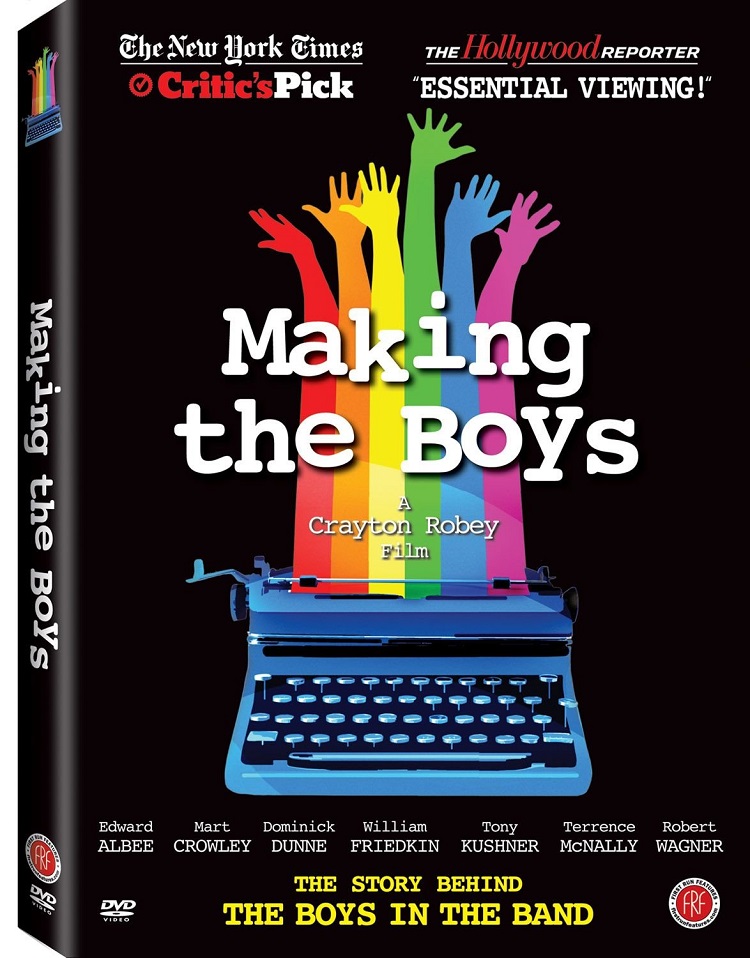
Written by handyguy
Making the Boys (awkward title) has a great subject for a 45-minute documentary: the story behind the groundbreaking play and movie The Boys in the Band. It actually runs a bit over 90 minutes, so there is more than a little padding. Luckily, most of that padding is pretty entertaining, too.
The Boys in the Band is an ensemble piece for nine gay male characters, set at a birthday party in a New York apartment (one of the “birthday presents” is a hustler named Cowboy). It was written in 1967 and opened in New York in 1968. The Stonewall riots that marked the beginning of the “modern” gay rights movement happened in June 1969. And William Friedkin’s movie version of Boys opened in 1970. The chronology is important, because in some ways, the material was politically and socially obsolete by the time the movie opened. Its caustic wit had made it a real audience pleaser and commercial smash in 1968; just two years later, some theaters showing the film version were picketed by gay activists – although many audiences, gay and straight, then and now, find the film enormously entertaining.
This deep ambivalence about the play is thoroughly explored in the documentary, and its best moments arguably come when Edward Albee, Larry Kramer, and others give voice to the discomfort many people have felt, even as they laughed at the acerbic one-liners and flamboyant performances. It’s certainly possible that many condescending and/or bigoted straights found in the material a validation of their attitudes toward gay people. And there are many gays who have found uncomfortable yet also liberating truths tucked in among the stereotypes, the sitcommy zingers, and the very unsubtle dramatic structure. Yet nowadays, time has softened some of the political misgivings, and many people appreciate the play as a funny and poignant period piece: Can you believe that used to be us?
Although the documentary takes time to explore what life was like for gay Americans before the play, at the time of the play and movie, and in the years since (pointedly noting that many young gay men have never heard of The Boys in the Band), Making the Boys is really structured as the story of playwright Mart Crowley. A Hollywood hanger-on (and pal of Natalie Wood) in the mid-1960s, he was at a loss for real direction in his life when in 1967 he had the inspiration to write about what he knew well: the bitchy wit and hostility that could characterize certain gay personalities, especially when fueled by alcohol. (The similarities to the bitter, boozy verbal sparring in Albee’s Who’s Afraid of Virginia Woolf, as well as in gay movie faves like All About Eve and The Women, were not accidental.)
The groundbreaking nature of The Boys in the Band was real and striking: no one else was writing plays in which all the characters were gay. This prevented some from seeing the material’s commercial potential, and it made the casting very difficult: agents and actors weren’t convinced anyone should have this on his resume. Richard Barr’s Playwrights Unit (over the objection of business partner Edward Albee, apparently) gave the show its first incarnation, a five-week run downtown. On opening night, the theater was half full. The next day, word was out: lines for tickets stretched for blocks, celebrities began regularly showing up at performances, and the run was quickly sold out. A few months later, the play opened off-Broadway and ran 1001 performances.
The documentary is packed with articulate interviews and great vintage footage and sound clips. An especially poignant section follows what happened to the cast, director, and Crowley in later years. Many of the stories are sad: some actors were advised to remove the play (and movie, which featured all of the original cast) from their resumes, although Cliff Gorman, Leonard Frey, and Laurence Luckinbill had successful careers. Director Robert Moore and several cast members died of HIV/AIDS in the late 1980s/early 1990s. Crowley wrote another play, which flopped, then left the country for a long period of professional inactivity (and heavy drinking). He eventually teamed with Natalie Wood’s husband Robert Wagner to be a producer and writer for the TV series Hart to Hart. (A segment on Wood’s death has an eerie timeliness, given last week’s headlines about a reopening of the investigation.)
The extras on the DVD of Making the Boys include some deleted scenes, many of which are not directly related to the play or movie – that is to say, still more padding. But they are all enjoyable, and one is more than that. Brief bits from home movies of Roddy McDowall’s beach parties circa 1965 are featured in Making the Boys itself. An extended sequence of these clips is included as an extra (and still more can be found on YouTube). They feature Jane Fonda, Anthony Perkins, and many others when they were very young, in delightful unposed footage.
Making the Boys is a must for aficionados of theater, movies and gay cultural history. It could be tightened up a bit, but I didn’t mind, and I don’t think most other viewers will, either.